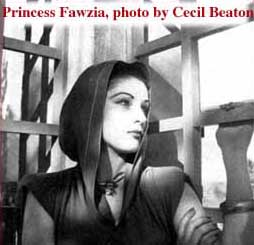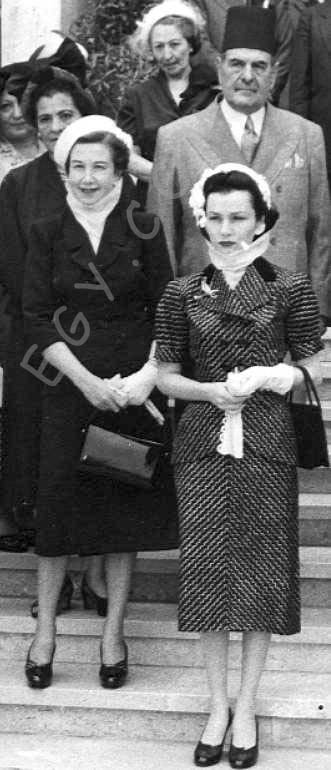by Samir Raafat
EGYPTIAN MAIL, January 15, 1994

|
|
|
|
|
|
EGY.COM - HISTORICA
|
|
by Samir Raafat
EGYPTIAN MAIL, January 15, 1994

WHAT do printer-publisher Maged Farag, author Adel Sabet, German-language tourist guide Amina Radi and the author of this article have in common? Precious little. Yet, an unusual undertaking brought them together where each contributed towards the successful realization of their common goal -- a handsome pictorial entitled 1939, The Emperial Wedding (published by Max Group, 1993).
Besides his possessing a printshop, Magued also has the stamina and courage required for such a novel undertaking. Septuagenarian Adel was the group's eye witness to the event and had a vivid story to tell. Amina, graciously contributed the wedding's black and white photos without which there would have been no undertaking. Her mother, Princess Nimet-Allah Ibrahim Halim, is the only surviving great-granddaughter of Viceroy Mohamed Ali. All his other living descendants are five or six times removed.
As for the author of this article, it was he who came up with the idea and concept. Armed with Amina's pictures plus some of his own photos and documents, he approached Magued to enlist him in the project. Magued needed no further convincing. The introductions over with, everyone got cracking. Who knew then, that it was the beginning of many more books of the same genre. Magued Farag certainly knew a good thing when he saw it.
 While the wedding in question may have gone into the dustbin of history, this new pictorial, appearing as it did almost fifty-four years after the fact, is a testimonial of Egypt's once faded splendor.
While the wedding in question may have gone into the dustbin of history, this new pictorial, appearing as it did almost fifty-four years after the fact, is a testimonial of Egypt's once faded splendor.
The fairy tale begins with the arrival in Egypt of Persia's crown prince, Shahpour Mohamed Reza Pahlevi. He had come to ask for the hand of Egypt's beautiful teen-age Princess Fawzia Fouad, King Farouk's sister and one year his junior. Despite a looming World War on the horizon, the press and media went agog with this happy event. Cairo was ablaze in welcome celebrations. And no one was about to criticize the unprecedented display of pomp and ceremony that ensued.
Even before war broke out, Egypt was in excellent economic health when compared to the here and now. None of those present-day deficits inflation, disguised employment, recessions, depressions etc. As for corruption, it existed then as it does today; some things simply won't go despite loud claims to the contrary. The principal malaise however, continued to be Britain's unwelcome presence in Egypt epitomized by its overbearing and disliked ambassador, Sir Miles Lampson.
 The bullying Lampson aside, Egypt in 1939 was on the threshold of an economic boom as hundreds of thousands of Allied military troops spent what time they had and what little money they received in the souks and bazaars. In fact, W.W.II was responsible for Egypt's first modern tourist boom. On the other hand, raw material shortages, rationing and lack of imported material gave a much needed impetus to Egypt's fledgling industry. A rising demand for its traditional agricultural staples soared to stratospheric heights. The combination of both factors, created instant fortunes compounded by a healing trickle effect as money made its way from businessmen and compradores to the disfavored urban classes.
The bullying Lampson aside, Egypt in 1939 was on the threshold of an economic boom as hundreds of thousands of Allied military troops spent what time they had and what little money they received in the souks and bazaars. In fact, W.W.II was responsible for Egypt's first modern tourist boom. On the other hand, raw material shortages, rationing and lack of imported material gave a much needed impetus to Egypt's fledgling industry. A rising demand for its traditional agricultural staples soared to stratospheric heights. The combination of both factors, created instant fortunes compounded by a healing trickle effect as money made its way from businessmen and compradores to the disfavored urban classes.
As usual in such circumstances, newly acquired wealth was already being flaunted. Hard to believe that only half a century Cairo was a prosperous cosmopolitan hub and Alexandria one of the Mediterranean's most thriving ports. Equally hard to imagine is that the populations of these two urban centers were in proportion to their physical size so that pedestrians could actually enjoy walking down the shaded boulevards!
While 1939, The Emperial Wedding illustrates a prismatic aspect of Egypt's prewar court life, it nevertheless covers a historic fairy tale wedding starring of one of the most beautiful princesses of her generation and attests to Egypt's enlightened period when the rest of this region was in the throes of the dark ages. The yet-to-emerge oil sheikdoms were still unknown tribes with tattered flags. Alas, the roles would soon be reversed.

While many are grumbling today that publishing such a pricey book (700 collectors' copies at LE 1,000 each) is tantamount to a faux pas in these trying and explosive days, our reply to those diehard "republicans" is why sacrifice quality and why continue to deny part of Egypt's history. Why pretend this wedding never happened. It did take place and was front page news for an entire month. One need only point out to the unending tasteless hoohaas and the extraordinary funds -- if not more -- which have been wasted for lesser celebrations in the subsequent post-revolutionary days. Moreover, at a period where Arab "unity" continues to suffer from chronic ailments, the wedding of Princess Fawzia to the Crown Prince of Persia was a dynastic alliance that concerned two of the region's most powerful players.
Like in most fairy tales, reality inevitably intrudes and in this particular case with a twist of irony. After a short, unhappy marriage, Empress Fawzia deserted her husband returning to Egypt to face the last decade of her brother's tottering court. After the 1952 coup she retired from the public eye watching as her ancestors were being ridiculed by the new regime. Meanwhile, the jilted Shah having recovered from his separation from the princess, and to ensure his Imperial succession, successively married two Iranian women -- Soraya Esfandiyari and Farah Diba, both commoners.
 It would be decades later, in 1979, following a spate of local and international machinations, that the Shah, like King Farouk, was repudiated by his people. One by one, his former friends and Western allies turned their backs on the Peacock Throne. From Morocco, to Mexico to Texas and Panama, the ex-Shah wondered desperately. No one gave him asylum. He had become a political liability and no one wanted him around.
It would be decades later, in 1979, following a spate of local and international machinations, that the Shah, like King Farouk, was repudiated by his people. One by one, his former friends and Western allies turned their backs on the Peacock Throne. From Morocco, to Mexico to Texas and Panama, the ex-Shah wondered desperately. No one gave him asylum. He had become a political liability and no one wanted him around.
There was only Egypt.
It was in Egypt that the fallen monarch found comfort and shelter. He was welcomed as though still a ruling head of state.
The ex-emperor died in July 1980 at the Maadi Military Hospital, a pariah deserted by the bastions of democracy. The following day he received a shoddy state burial deplete of heads of state or leaders of once friendly governments. It was attended by Sadat who was accompanied by several ex-presidents.
The ex-Shah was laid to rest in Cairo's Rifa'i Mosque in a chamber adjacent to that of the forgotten King Farouk. The former brothers-in-law had met again, this time in death.
The Shah's long trip into oblivion had begun.


L-R: Samir Raafat, Maged Farag (and his wife Assi Geera), Robert Pelletreau and Adel Sabit commemorating the handing over to Ambassador Pelletreau two copies of The Emperial Wedding for the benefit of the Library of Congress. Unfortunately, the fourth member of the quartet, Amina Radi, could not attend.
For House of Mohammed Ali family tree click HERE
COMMENTS
Subject: Fwd: Requiem in Cairo, (1060)
Date: Wed, 08 Nov 2000 14:42:13 GMT
From:Cyrus Kadivar
Read your story on the Imperial Wedding of the Shah and HRH Fawzieh...I've been to Cairo twice and wrote an article some time ago which may interest you if you click below. I also saw Mr Sabet's book on the Royal Wedding and believe it was a magnificent work of art. How may I obtain a copy and what is the price these days? Finally do you know of anyone who met the Shah in his last days in Egypt. I'm collecting stories of his last days a bit like Naguib Mahfouz's Akenaten: Dwellers of the Truth...All the best...do get in touch...
Cyrus Kadivar
|
|
|
|